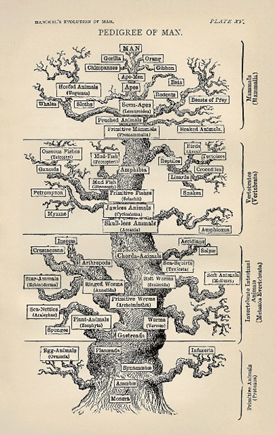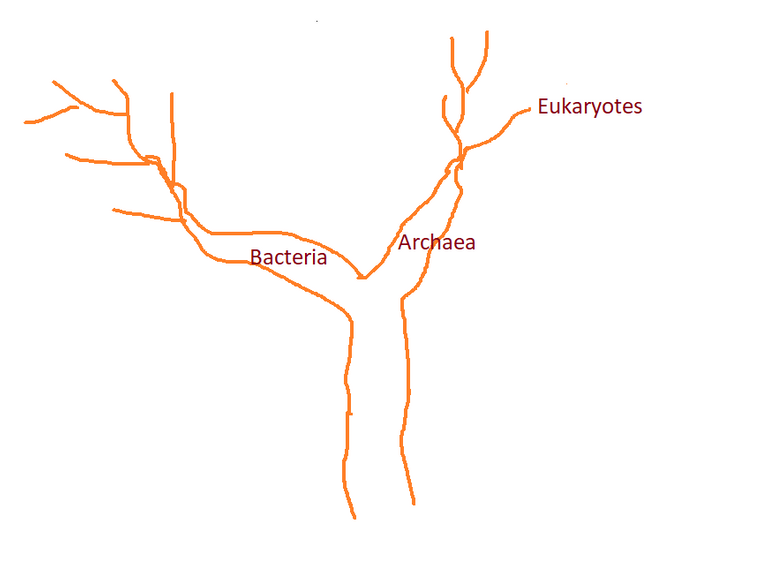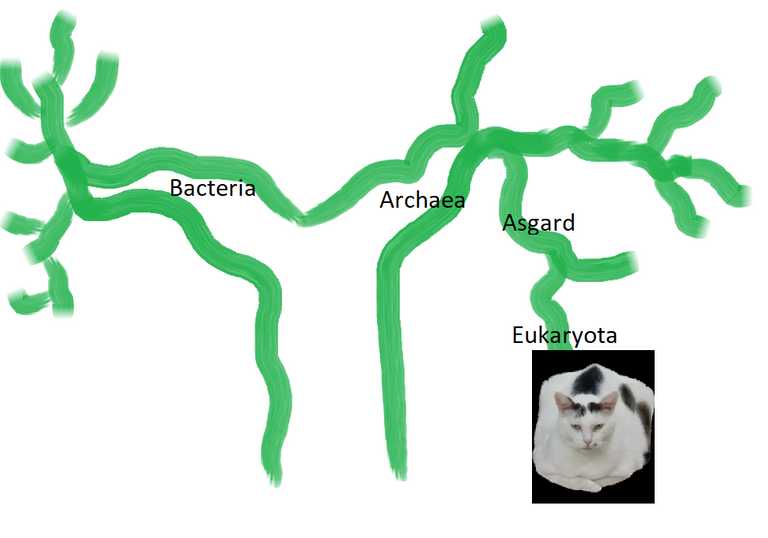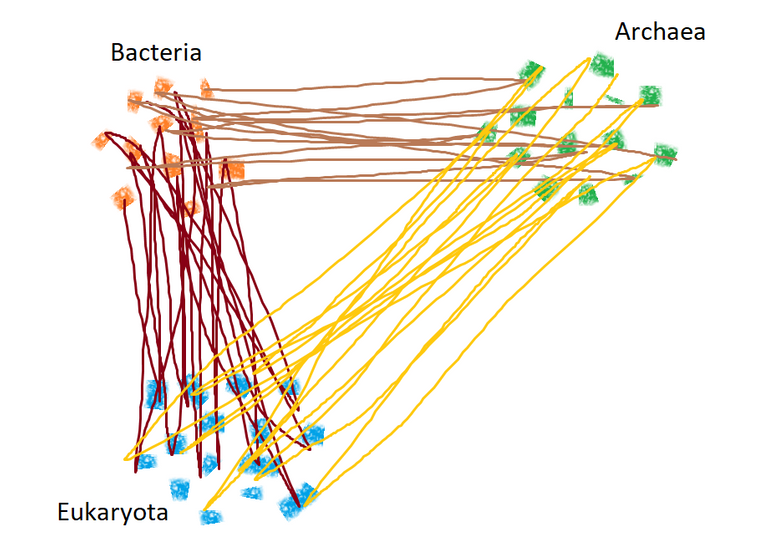We are all Asgardians
Here is the first draft of the second part of a chapter in a book I'm working on following the branches of the Tree of Life step by step from the dawn of life all the way to humans. It is based on a blog series I wrote here on Hive some years ago, vastly expanded and updated. It is subject to significant change after publishing it here!
The book will require heavy illustration which does not yet exist, so most images here are made in MS Paint, for now, or public domain.
The Death of a Tree (continued)
Previously:
We generally still have no idea how life can be neatly grouped up. The tree metaphor is on shaky grounds from the beginning
It's divided into 3 sections: Bacteria, Archaea and Eukaryota, even though the former two look basically the same. We do things based on genetics now, not appearances.
And now, the conclusion:

It was also discovered that despite our differences, there were surprising similarities between Archaea and Eukaryotes, and that’s why there is a general agreement that we Eukaryotes are the closer cousins. It remains to be a tricky subject. In some ways such as the possession of certain genes and enzymes, the Euk-Arc relationship wins. But in others such as the proteins directing cell division, it’s the Bac-Arc relationship that shares more resemblances.
This remained the status quo for a while. Three domains. Three types of life, separated at certain points in history. Unfortunately, life has no obligation to fit into nice little tree pictures, labels and check boxes we humans so desperately need to make sense of the world around us. Just for fun, mother nature wedged an oversaturated wrench into the system for us to try and remove with a soggy toothpick.
Nature decided to inform us that there is no tree.
It’s nothing unique in the academic world to perpetually update, revise and correct certain elements of such complex systems. This has been going on in biology non-stop and many scientists clash with others on perhaps infinite matters. The tree itself has been undergoing substantial changes ever since its conception. In 1758, taxonomist Carl Linnaeus had organised things into plants, animals, and minerals in his book Systema Naturae with animals splitting into 6 groups, all completely wrong, with spiders and scorpions shoved in with insects and everything else being categorised based on nothing more than simply what he thought they were.
The relationships between different species were long known, but demonstrably not well understood, with varying examples continuing to pop up throughout the 1800’s, including a sort of demonstrative sketch in Darwin’s On the Origin of Species.
It wasn’t until about 1879 when zoologist Ernst Haeckel, after a few earlier attempts, published The Evolution of Man with this monstrositree within:

This was quite the biased tree! The idea long settled in man’s mind is that man’s position is obviously the final form of life. The apex creation closest to the sun. Typical. Either way, now the metaphor was properly ingrained in our civilisation, getting rid of the concept entirely seems a bit much. It’s going to need a lot of evidence to even touch such a well-marketed idea.
As it turns out, not everybody was always happy with Woese’s Three Domain idea from the very beginning. One critic at the time of its inception was Jim Lake. In the 1990’s, he was arguing that us Eukaryotes were not simply more closely related to the archaea, but actually branched off from within them, and we should therefore revert back to a two-branched tree after all. He came to this conclusion by noting that the genes of eukaryotes were more closely related to one particular type of archaea – the Eocytes – than to all other types. It didn’t make sense to have a third separate domain for us. At the time, this idea was neglected and criticised, but as the decades passed, evidence piled up supporting his hypothesis, and it seems most researchers in this field are now pretty much on board with the idea that the three-domain tree is dead, and Jim Lake gets righter and righter.

Made by me, if you couldn't guess
Hopes of an answer boiled down to the Nordic Gods of Asgard hiding away in Loki’s Castle.
You can try praying, but that's not what I mean. Lokiarchaeota was an aptly named Archaea discovered on a deep-sea thermal vent called Loki’s Castle somewhere between Greenland and Norway in 2015. Since then, genetically similar Odin, Freyr, Thor, Balder and more miniature immortals have all been discovered around the world, from New Zealand to Colorado, and combined into the superphylum group name Asgard.
The relevance of these Nordic microbes cannot be understated. Further investigation concluded that the Asgardians are our closest living relatives from the Archaea domain outside of the Eukaryota group. As of June 2023, researchers from the University of Texas took it one step further and announced ‘with high confidence’ that Eukaryotes – and therefore all complex life – are actually placed in a clade within Asgard! It is due to a happy series of events that we now find ourselves to officially be Asgardians. I don’t know about you, but I can feel the lightning running through my veins. Maybe I’ll see a doctor just in case.
This makes sense the more you look into it. A lot of elements we once thought unique to eukaryotes were also found in the Asgard Archaea. Members from the Asgard group encoded signature eukaryote proteins that do things like remodel membranes and synthesise RNA.
This is all much-needed powerful evidence supporting Lake’s two-domain hypothesis that was once so heavily shunned.

Made by me, permission given by @smashthecat
But that would be too simple.
So, let’s go back to school. I’m sure you’ve at least heard of the word mitochondria along with its exhaustingly overused but accurate tagline, ‘the powerhouse of the cell’. With that information alone, we can deduce that mitochondria are things inside of cells that powers them to function. It’s a lot more complex than that, but we’ll run with the basics.
Mitochondria was not always part of the cell recipe. In fact, it is an alien invader from billions of years ago which, under unknown, mysterious circumstances, got ingested, infected, or otherwise incorporated into a cell where it surprisingly continued to function in a process called symbiosis. This symbiosis happens across all of nature, constantly. A good example is our gut bacteria which, although is not us, is still vital for our digestion among other things we need to survive. Flowers evolving to feed birds and bees is another example of symbiosis, as each benefit from the partnership; bees get fed, flowers get pollinated.
It has long been believed that this alien invader was some kind of bacteria which somehow benefitted the Eukaryotic cell by staying alive inside and kicking off that new partnership, but recently, the idea has been suggested that this bacterium was actually engulfed by an Asgard-related Archaea, from which the path towards Eukaryotes was then formed, with those unique mitochondria giving us unlimited, god-like power along the way.
Still feeling like Archaea are insignificant and pointless?
You might be starting to see where the tree model breaks down somewhat now. If our cells are a composite of both Archaea and the symbiote Bacteria, then it gets a lot harder to distinguish any one domain from the other. Eukaryotes may indeed be the freakish children of two very unrelated microscopic blobs. Instead of a tree, we might have to settle with something more like this:

Made by me, if you couldn't guess
Still following? Well get ready because it gets even worse for our poor tree.
You see, Bacteria and Archaea lack a certain… je ne c'est quoi. They never bothered with the cumbersome process of sexual reproduction. In terms relevant to this story, this is called Vertical Gene Transfer, where genes are transferred from one generation to the next. Like, when your parents fell in love and… I’m going to assume I don’t need to explain that.
Instead, a much more efficient process takes place among these microscopic worlds: Lateral Gene Transfer (LGT). This is a more horizontal approach of exchanging genetic material between one individual and another. It would be like if your mother, perhaps after a romantic anniversary dinner, literally transferred some of her genes into your father, making your father part-mother, before he promptly divides into two separate father-mother hybrids. (visual representation needed!)
There are a few methods bacteria and archaea use to accomplish this, but suffice it to say that it’s generally a pretty common past time in the bacterial and archaeal world. The problem this raises is from back in the early days of life when transferring genes between bacteria and archaea was not only doable but particularly common, which if you think about it is even more surprising than a giraffe creating offspring with a stinkhorn. It was a genetically simpler time back then.
The dream of forming a genetic clade that made any sense in the early stages of life was starting to look impossible, perhaps even inconvenient. Clear distinctions between the three (or two) domains might only have become apparently countless millions of years into life’s journey when complexity started to rise.
So, call it all what you will; a tree, a ring, a web. I must remind you, however, that despite domains being the broadest possible category for life as we know it, even they are still being figured out, with researchers updating, fighting, rescinding and refining every single day. It is the most fun part of any expedition into the natural world, and since we have finally taken our first step forward and started climbing into complexity, things will finally start looking more tree-like, even if the base is all messed up.
Be prepared for a lot of windy weather and shaky branches. I don’t know about you, but I wouldn’t have it any other way.
.
Sources:
Youtube: Are We All Actually Archaea?, PBS Eons
Our deep origins: deciphering the earliest branches on the tree of life
Phylogenomics provides robust support for a two-domains tree of life
dx.doi.org/10.1098/rstb.2014.0321
doi.org/10.1038/nmicrobiol.2017.40
doi.org/10.1038/s41586-023-06186-2
How did cells function if mitochondria was never part of them in the first place, are you saying cells were lifeless? Because mitochondria in cells help with basic aerobic activities
Well that's basically asking 'how do bacteria function', right? They just get energy in different ways, namely anaerobic, but it's less efficient - This is a good point I should include!
Oh! That makes sense. Thanks
Thanks for your contribution to the STEMsocial community. Feel free to join us on discord to get to know the rest of us!
Please consider delegating to the @stemsocial account (85% of the curation rewards are returned).
You may also include @stemsocial as a beneficiary of the rewards of this post to get a stronger support.
The epilogue, man... What an amazing two-piece post you've made. By the way... The story behind the tree of life is fascinating indeed. Didn't aware of that 'til now. Thank for that and for the joke with Thor on it. @mobbs
Glad you enjoyed! I'd like to see more of this in the StemSocial feed from others, there's a lot of talent out there!
You should see my next post on this community, man. If you agree, I could tag you. Thanks for the reply
I was thinking about comments and was going to bring up endosymbiosis and horizontal gene transfer.
Ever took a look at ontology? It is pretty interesting stuff from a philosophical perspective.
Yeah I didn't wanna go too far into HGT/LGT, I touched on it more in the original blog but it got a bit too wordy for what I'm aiming to do... and ontology can get way too brain-sweaty!
Interesting! I've looked into this following Aron Ra's Systematic Classification of Life series.
Oh nice, similar concept of following the timeline! Although his content is very dry and lecture-like. I'm trying to appeal to idiots like myself, but also go a little deeper, making stops along the way to focus on certain evolutionary developments specifically such as embryos, bones, trichromatic vision, etc.
That being said, this is another great resource for answering certain questions I have, i'm pretty overwhelmed with about 40 open tabs on a single topic at the moment, can't read so much!
Sure!
About "dry" I guess it's subjective. He's quite entertaining to me and other followers. He makes jokes. He's not a professor or a teacher, but he's a public speaker. It's a long series of 50 episodes.
Part of his goal is not only to teach this technical knowledge to college students, as Professor Dave Explains would do, but also to educate evolution deniers to open their eyes. It is noticeable when he concludes his videos. He also wants to appeal to science advocates, typically atheists so that, they will learn about these things and even use them to their advantage.
Yeah I appreciate his work for sure. I got one video on a tab now to help clarify something later. I generally gave up following these horsemen of atheism and the like, it ultimately became a preach to the choir. But this approach of more just pure education is going to appeal to a lot more of those silent demographics of religious who are not sure what is true. Kudos to him